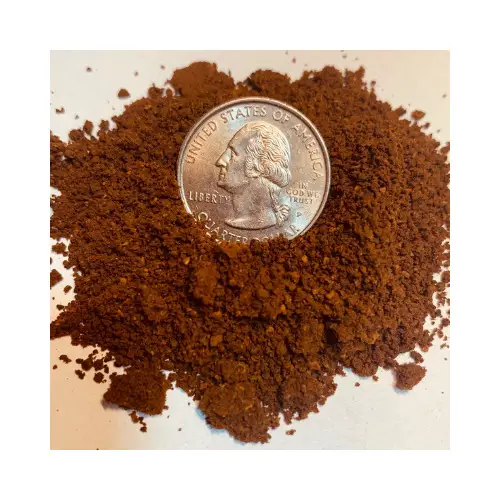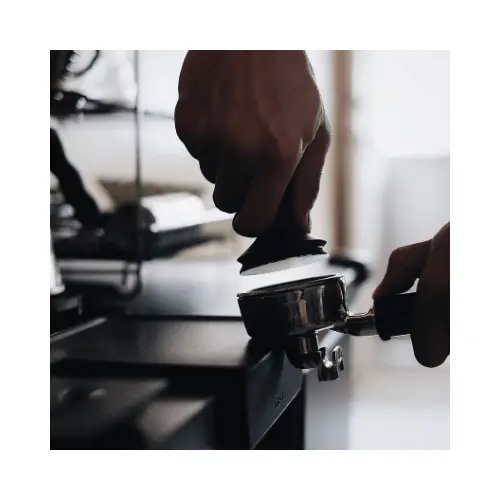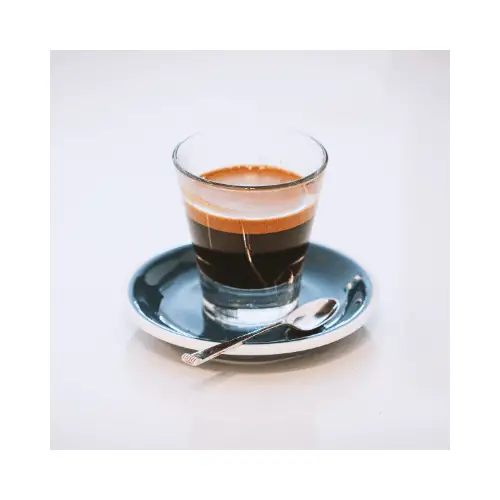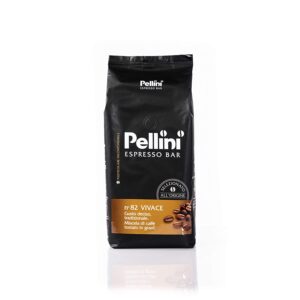Espresso and coffee are often regarded as the same thing. Although both are made from the same coffee beans each drink has a unique brewing method which results in different flavors, textures, and caffeine content.
Coffee, in most cases, is made by steeping beans in hot water, but espresso is brewed, or pulled, through a special machine that extracts a very concentrated dose of coffee we call a shot of espresso.
Making espresso at home can be a daunting task, especially for anyone new to the process. If you follow these simple steps I put together, you’ll know how to make the perfect espresso in no time.

What We’ll Be Using
Espresso machine
You’ll need an espresso machine to learn how to make great espresso. If you already have one, great. In case you’re looking for one, I put together a list of all the best espresso machines I would recommend for home use.
Portafilter
Your coffee machine should come with a portafilter. It’s definitely the most identifiable espresso tool. We will place our coffee grounds into the round steel filter and use the handle to attach it to the espresso machine.
Coffee grinder
Burr grinders tend to provide a more uniform coffee grind. In case you need a refresher on the differences between burr and blade coffee grinders, you can find it here.
1 tablespoon of coffee (14-18grams)
You can use your personal favorite bean to make espresso. If you’re looking for a recommendation, you need to try Pellini Vivace, they are absolutely perfect for espresso. I wrote more about them on my list of the best coffee beans ideal for espresso.
Tamper
A tamper is what we’ll use to even out the coffee grounds in the portafilter. Your espresso machine should come with a tamper included. It has a short handle and a flat base that fits into the top of the portafilter.
Water
Coffee machines need water. To keep things simple, a shot of espresso is made with one ounce of water, and a double shot is made with two ounces. I suggest using filtered water for the best results.
A glass cup
A clear cup will make it easier to see the different layers and colors of an espresso. Once you’ve mastered the brewing technique you can pull shots right into a demitasse.
Optional Equipment
A digital scale
A scale isn’t mandatory, but most baristas like to use one. Otherwise, how would you know which variables to adjust?
A timer
We will need to time the extraction of our espresso. It’s important to have a timer ready when pulling a shot.

Step 1: Get your coffee beans ready
Avoid using pre-ground coffee beans at all costs. You’ll want to grind fresh coffee beans every time you make espresso.
A single shot of espresso needs 8-12 grams of coffee. Roughly a flat tablespoon of coffee beans. We’re going to be using 14-18 grams of coffee to pull a double shot of espresso. If you don’t have a digital scale 14-18 grams is roughly 1 heaping tablespoon of coffee.
You should bring your coffee beans to a fine grind. Aim for an even batch resembling granulated sugar. The grind size can make or break your espresso, so it’s really important that you get it right.
If your grind is too fine the espresso will taste bitter and burnt. Also, the extraction will take longer than it should.
On the other hand, if your grind is too coarse, the shot will taste weak, watery, and sour.
Be patient when using a new coffee machine. It will take time to find the ideal grind size to make the perfect espresso.

Step 2: Tamper your coffee
Pour the beans from your grinder into the portafilter. Use the tamper to press down on the coffee grounds. The purpose of tampering is to make the grounds even and compressed.
One technique for tampering involves using a scale. Gently place the portafilter on a digital scale and apply 30 pounds of pressure.
I personally don’t use a scale. Instead, I like to use the edge of a countertop or a table and press the tamper down on my grounds until I feel them create a uniform puck.
If you’re not going to use a scale remember to avoid pressing down on the tamper with all your strength.
You want the coffee to be uniform and even, but not so compressed that it stops water from getting through.

Step 3: Pull a blank shot
Before you lock the portafilter into your espresso machine let some water run through the coffee maker for 2 seconds and clean the spout of any old coffee, dust, or dirt.
Use a glass to catch and dispose of the dirty water.
Here comes the fun part!
Insert the portafilter into the espresso machine, place your glass under the filter, and get ready to pull a shot.
Step 4: Extract a shot of espresso
I suggest having a timer ready for this step.
Extracting your espresso should take between 20 to 30 seconds. Start your coffee machine and timer at the same time and notice the coffee begin to stream through.
If your grind and temp are correct the stream will be constant. The first drops of your coffee should be dark brown and then turn into a golden brown stream.

This is where you need to examine the results. Did your stream break? If so, then your tamper was uneven.
If your extraction was too quick, then your grind is too coarse, or the tamp wasn’t firm enough.
On the other hand, if your shot took too long to pull, your grinds may have been too fine or too compressed in the portafilter.
Each coffee machine is a little different, therefore you’re going to need patience and practice to master your espresso extraction.
The results you’re aiming for
The espresso you pulled should be dark brown, almost black, in appearance. The shot should be covered with a creamy golden brown foam called crema. Ideally, the foam layer should be thick, a quarter of the total height of the coffee.
Your brew should have a rich aroma and a potent flavor. When consumed shortly after being pulled, espressos should have no lingering aftertaste.
On average, it takes about 20-30 seconds to pull a shot of espresso, so aim for that range.
Espresso Variables to Know About
Water
It’s always important to you quality water when pulling a shot of espresso. I suggest using filtered water. If you don’t have filtered water, bottled water will do fine. Although some places have drinkable tap water I still prefer to filter mine before adding it to a coffee machine.
Water Pressure
The espresso needs at least 9 bars of pressure to make a perfect espresso. Most espresso machines will be set to this level but it’s a good idea to check when you first buy your coffee maker.
If your pressure is too low, your extracting will take too long, and your coffee will taste burnt. Really high water pressure will ruin your espresso and make a mess in your kitchen.
How to Store Your Coffee Beans
Since using fresh coffee beans can make all the difference I recommend a good strategy for keeping your beans fresh. If you’re interested in keeping coffee at its fullest potential, here is a helpful guide on keeping coffee beans fresh for longer periods of time.

Troubleshooting Crema
Although crema is often used as a judging tool for good or bad espresso, it’s perfectly normal not to get cream on your shots when you’re a beginner.
There are several reasons why you might be missing out on crema on your espresso. Using the wrong grind size, brewing stale coffee, or using the incorrect coffee to water ratio are some of the reasons why your espresso might be missing its delightful creamy topping. This article will show you more detail on how to get crema on your espresso.
How Long Before a Shot of Espresso Goes Bad?
There’s a common myth circulating around the coffee community that a shot of espresso expires or ‘needs to be saved’ after only 10 seconds.
Shots of espresso don’t expire, although, their flavor and texture begin to change significantly after about 10 seconds. Even though the body and crema of the shot begin to mix, altering its flavor profoundly, that doesn’t mean the coffee has expired.
A shot of espresso certainly can become a cold, ashy mess but it takes a little longer than you think.
Quick Notes
Here are the jot notes about making a shot of espresso:
- Shred your coffee beans to a fine grind.
- Place the grounds into the portafilter.
- Tamper the coffee into a tight, smooth puck.
- Warm-up to the espresso machine and your glass.
- Connect the portafilter into the espresso machine.
- Extract a shot for roughly 20-30 seconds.
Follow these simple steps to get the perfect shot of espresso every time.
Summary
Making espresso at home can be tricky at the start, but it has a lot of benefits in the long run. There are so many different types of coffee you can begin to experiment with once you’ve mastered espresso. Did you know the mocha, americano, and flat white all start with an espresso?
These simple steps will guide you on your way to becoming a pro-barista. Remember to give yourself time and patience to figure out all the variables involved when making espresso. No one pulled a perfect shot on their first try, it takes a lot of practice by trial and error to find out what works best for you and your coffee machine.
Related Questions
What is the Best Espresso Coffee Machine?
Even though everyone will have their own preference I recommend you use the Gevi semi-automatic espresso machine. I made a list of all the best affordable espresso machines on the market, where you will find more information about this wonderful coffee maker.
Can You Make Espresso from Regular Coffee?
The simple answer is yes, you can make espresso from regular coffee beans. You don’t need to purchase a specific type of coffee to enjoy this type of coffee.
I suggest trying Pellini Vivace because it’s as close as you can get to the authentic cafe-style espresso at home. If you’re looking for more coffee beans to try in your espresso machine take a look at my coffee bean hitlist.
Is Espresso the Same as Black Coffee?
Espresso and black coffee are not the same things. Espresso is a potent shot of coffee whereas black coffee is your regular morning pick-me-up. Even though espresso has more caffeine per 1oz serving, a whole mug of black coffee has significantly more caffeine than a single shot of espresso.
I’ve always seen coffee as a way of bringing people together. Everywhere I go people seem to enjoy a fresh cup of coffee and that’s what drives my passion. There’s always a new brew to master, and there’s always a new face to enjoy it with. Hitch a ride with me on a coffee-fueled adventure to find a perfect cup.


